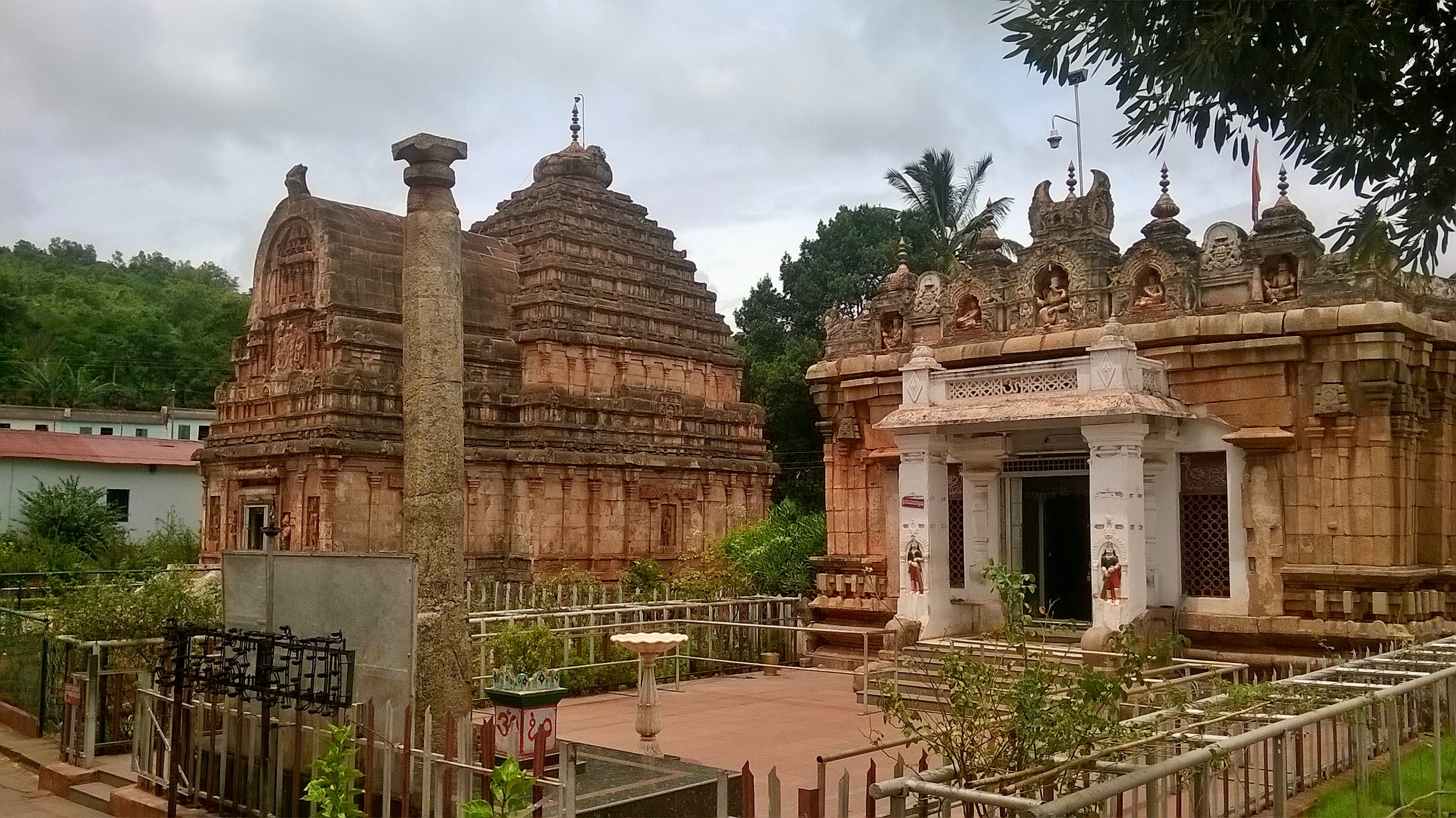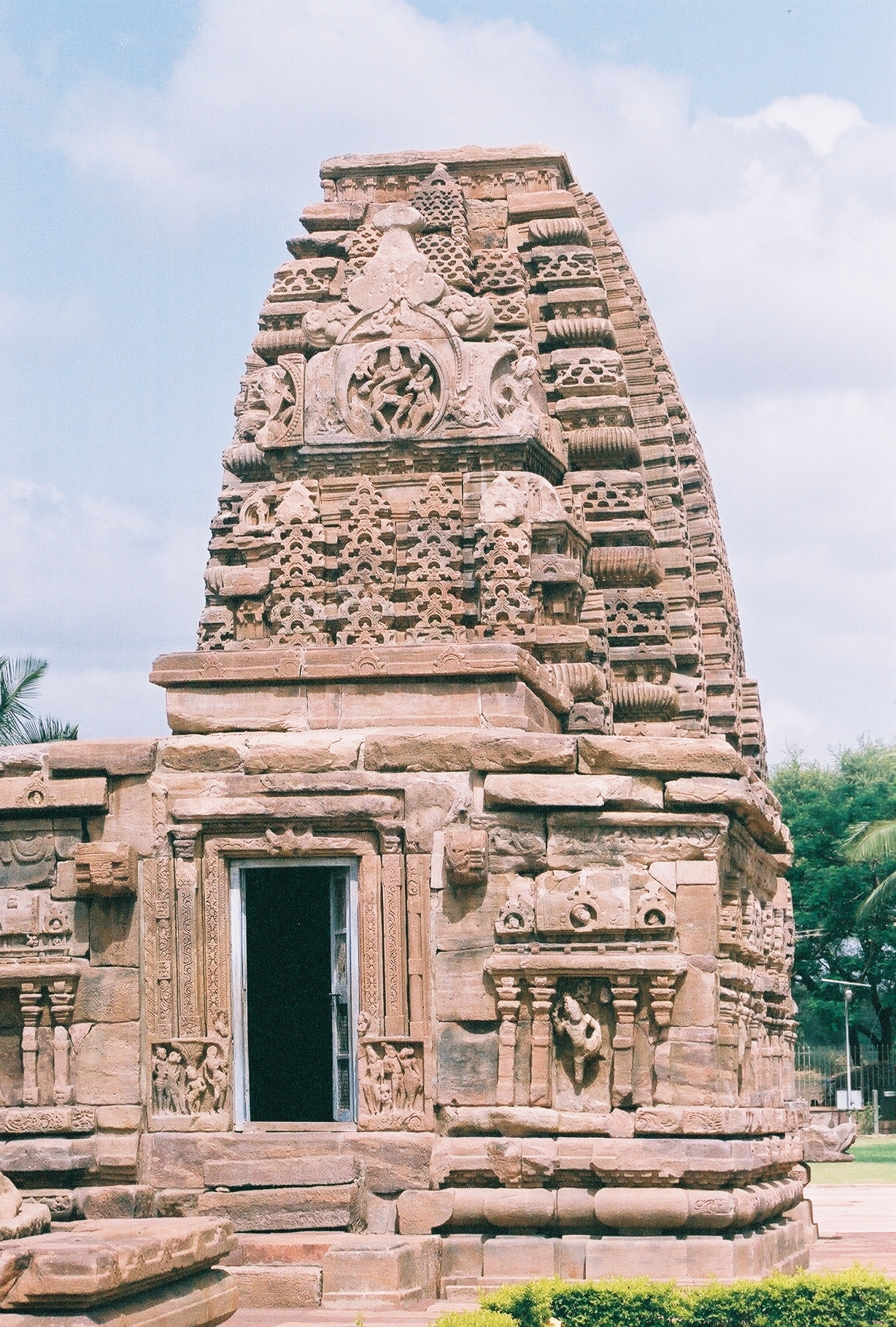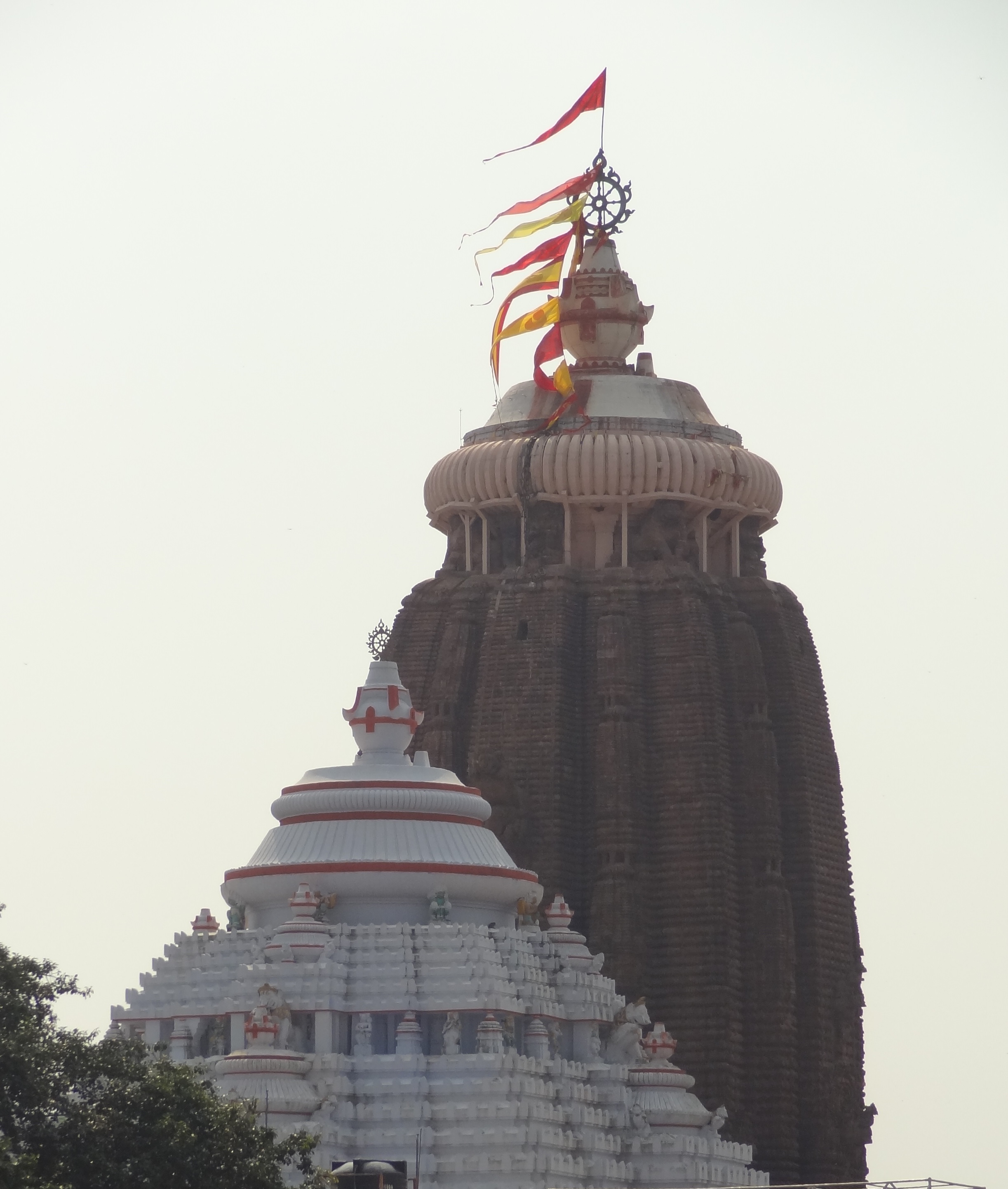|
Parvati Temple, Sandur
Krauncha Giri is a small settlement in Karnataka, India, about 10 km from Sandur in Bellary District. It is notable for two ancient Hindu temples which are in the same compound, and are both protected monuments. The more famous in religious terms is the Kumaraswami Temple (8th-10th century), believed to be the first abode in south India of Murugan or Karthikeya, the Hindu god of war, son of Parvati and Shiva, and brother of Ganesha. To art historians the Parvati Temple beside it (7th-8th century) is the more unusual in terms of Hindu temple architecture. Temples The complex houses temples of Parvati and Kumaraswami. The Ganesha idol in the Kumaraswami Temple is more popular these days than the main deity Kartikeya. Both monuments are now a protected monuments. It was discovered by the local rulers, the Ghorpades, in the thickly-wooded Swamimale hill in the 15th century. Women were earlier strictly not allowed to enter the shrine. Murarirao Yeshwantrao Ghorpade lifte ... [...More Info...] [...Related Items...] OR: [Wikipedia] [Google] [Baidu] |
States And Territories Of India
India is a federal union comprising 28 states and 8 union territories, with a total of 36 entities. The states and union territories are further subdivided into districts and smaller administrative divisions. History Pre-independence The Indian subcontinent has been ruled by many different ethnic groups throughout its history, each instituting their own policies of administrative division in the region. The British Raj mostly retained the administrative structure of the preceding Mughal Empire. India was divided into provinces (also called Presidencies), directly governed by the British, and princely states, which were nominally controlled by a local prince or raja loyal to the British Empire, which held ''de facto'' sovereignty ( suzerainty) over the princely states. 1947–1950 Between 1947 and 1950 the territories of the princely states were politically integrated into the Indian union. Most were merged into existing provinces; others were organised into ... [...More Info...] [...Related Items...] OR: [Wikipedia] [Google] [Baidu] |
Ganesha
Ganesha ( sa, गणेश, ), also known as Ganapati, Vinayaka, and Pillaiyar, is one of the best-known and most worshipped deities in the Hindu pantheon and is the Supreme God in Ganapatya sect. His image is found throughout India. Hindu denominations worship him regardless of affiliations. Devotion to Ganesha is widely diffused and extends to Jains and Buddhists and includes Nepal, Sri Lanka, Thailand, Indonesia (Java and Bali), Singapore, Malaysia, Philippines, and Bangladesh and in countries with large ethnic Indian populations including Fiji, Guyana, Mauritius, and Trinidad and Tobago. Although Ganesha has many attributes, he is readily identified by his elephant head. He is widely revered, more specifically, as the remover of obstacles and thought to bring good luck; the patron of arts and sciences; and the deva of intellect and wisdom. As the god of beginnings, he is honoured at the start of rites and ceremonies. Ganesha is also invoked as a patron of letters ... [...More Info...] [...Related Items...] OR: [Wikipedia] [Google] [Baidu] |
Rashtrakutas
Rashtrakuta (IAST: ') (r. 753-982 CE) was a royal Indian dynasty ruling large parts of the Indian subcontinent between the sixth and 10th centuries. The earliest known Rashtrakuta inscription is a 7th-century copper plate grant detailing their rule from manapur a city in Central or West India. Other ruling Rashtrakuta clans from the same period mentioned in inscriptions were the kings of Achalapur and the rulers of Kannauj. Several controversies exist regarding the origin of these early Rashtrakutas, their native homeland and their language. The Elichpur clan was a feudatory of the Badami Chalukyas, and during the rule of Dantidurga, it overthrew Chalukya Kirtivarman II and went on to build an empire with the Gulbarga region in modern Karnataka as its base. This clan came to be known as the Rashtrakutas of Manyakheta, rising to power in South India in 753 AD. At the same time the Pala Empire, Pala dynasty of Bengal and the Prathihara, Prathihara dynasty of Malwa were gaining ... [...More Info...] [...Related Items...] OR: [Wikipedia] [Google] [Baidu] |
Chalukya Dynasty
The Chalukya dynasty () was a Classical Indian dynasty that ruled large parts of southern and central India between the 6th and the 12th centuries. During this period, they ruled as three related yet individual dynasties. The earliest dynasty, known as the "Badami Chalukyas", ruled from Vatapi (modern Badami) from the middle of the 6th century. The Badami Chalukyas began to assert their independence at the decline of the Kadamba kingdom of Banavasi and rapidly rose to prominence during the reign of Pulakeshin II. After the death of Pulakeshin II, the Eastern Chalukyas became an independent kingdom in the eastern Deccan. They ruled from Vengi until about the 11th century. In the western Deccan, the rise of the Rashtrakutas in the middle of the 8th century eclipsed the Chalukyas of Badami before being revived by their descendants, the Western Chalukyas, in the late 10th century. These Western Chalukyas ruled from Kalyani (modern Basavakalyan) until the end of the 12t ... [...More Info...] [...Related Items...] OR: [Wikipedia] [Google] [Baidu] |
Vimana (architectural Feature)
''Vimana'' is the structure over the ''garbhagriha'' or inner sanctum in the Hindu temples of South India and Odisha in East India. In typical temples of Odisha using the Kalinga style of architecture, the ''vimana'' is the tallest structure of the temple, as it is in the ''shikhara'' towers of temples in West and North India. By contrast, in large South Indian temples, it is typically smaller than the great gatehouses or ''gopuram'', which are the most immediately striking architectural elements in a temple complex. A ''vimana'' is usually shaped as a pyramid, consisting of several stories or '' tala''. ''Vimana'' are divided in two groups: ''jati vimanas'' that have up to four ''tala'' and ''mukhya vimana'' that have five ''tala'' and more. In North Indian temple architecture texts, the superstructure over the ''garbhagriha'' is called a ''shikhara''. However, in South Indian Hindu architecture texts, the term ''shikhara'' means a dome-shaped crowning cap above the ''vimana''. ... [...More Info...] [...Related Items...] OR: [Wikipedia] [Google] [Baidu] |
Sukanasa
In Hindu temple architecture a sukanasa ( sa, शुकनास, IAST: śukanāsa) or sukanasi is an external ornamented feature over the entrance to the garbhagriha or inner shrine. It sits on the face of the sikhara tower (in South India, the vimana) as a sort of antefix. The forms of the sukanasa can vary considerably, but it normally has a vertical face, very often in the form of a large gavaksha or "window" motif, with an ornamental frame above and to the sides, forming a roughly triangular shape. In discussing temples in Karnataka local authors tend to use "sukanasi" (the preferred form in these cases) as a term for the whole structure of the antarala or ante-chamber from the floor to the top of the sukanasa roof above. It often contains an image of the deity to whom the temple is dedicated inside this frame, or other figurative subjects. The vertical face may be the termination of a horizontally-projecting structure of the same shape, especially in temples with an antar ... [...More Info...] [...Related Items...] OR: [Wikipedia] [Google] [Baidu] |
Antarala
Antarala (Sanskrit: अन्तराल, lit. ''intermediate space'') is a small antechamber or foyer between the garbhagriha (shrine) and the mandapa A mandapa or mantapa () is a pillared hall or pavilion for public rituals in Indian architecture, especially featured in Hindu temple architecture. Mandapas are described as "open" or "closed" depending on whether they have walls. In temples, ..., more typical of north Indian temples. Antarala are commonly seen in Chalukyan Style temples in which the 'Vimana' and the 'Mandapa' are connected through the 'Antarala'. Notes Hindu temple architecture {{India-hindu-temple-stub ... [...More Info...] [...Related Items...] OR: [Wikipedia] [Google] [Baidu] |
Mandapa
A mandapa or mantapa () is a pillared hall or pavilion for public rituals in Indian architecture, especially featured in Hindu temple architecture. Mandapas are described as "open" or "closed" depending on whether they have walls. In temples, one or more mandapas very often lie between the sanctuary and the temple entrance, on the same axis. In a large temple other mandapas may be placed to the sides, or detached within the temple compound. Temple architecture In the Hindu temple the ''mandapa'' is a porch-like structure through the (''gopuram'') (ornate gateway) and leading to the temple. It is used for religious dancing and music and is part of the basic temple compound. The prayer hall was generally built in front of the temple's ''sanctum sanctorum'' (''garbhagriha''). A large temple would have many ''mandapa''. If a temple has more than one ''mandapa'', each one is allocated for a different function and given a name to reflect its use. For example, a ''mandapa'' ... [...More Info...] [...Related Items...] OR: [Wikipedia] [Google] [Baidu] |
Tamil Nadu
Tamil Nadu (; , TN) is a States and union territories of India, state in southern India. It is the List of states and union territories of India by area, tenth largest Indian state by area and the List of states and union territories of India by population, sixth largest by population. Its capital and largest city is Chennai. Tamil Nadu is the home of the Tamil people, whose Tamil language—one of the longest surviving Classical languages of India, classical languages in the world—is widely spoken in the state and serves as its official language. The state lies in the southernmost part of the Indian peninsula, and is bordered by the Indian union territory of Puducherry (union territory), Puducherry and the states of Kerala, Karnataka, and Andhra Pradesh, as well as an international maritime border with Sri Lanka. It is bounded by the Western Ghats in the west, the Eastern Ghats in the north, the Bay of Bengal in the east, the Gulf of Mannar and Palk Strait to the south-eas ... [...More Info...] [...Related Items...] OR: [Wikipedia] [Google] [Baidu] |
Dravidian Architecture
Dravidian architecture, or the South Indian temple style, is an architectural idiom in Hindu temple architecture that emerged from South India, reaching its final form by the sixteenth century. It is seen in Hindu temples, and the most distinctive difference from north Indian styles is the use of a shorter and more pyramidal tower over the garbhagriha or sanctuary called a vimana, where the north has taller towers, usually bending inwards as they rise, called shikharas. However, for modern visitors to larger temples the dominating feature is the high gopura or gatehouse at the edge of the compound; large temples have several, dwarfing the vimana; these are a much more recent development. There are numerous other distinct features such as the ''dwarapalakas'' – twin guardians at the main entrance and the inner sanctum of the temple and ''goshtams'' – deities carved in niches on the outer side walls of the garbhagriha. Mentioned as one of three styles of temple building in t ... [...More Info...] [...Related Items...] OR: [Wikipedia] [Google] [Baidu] |
Deccan Plateau
The large Deccan Plateau in southern India is located between the Western Ghats and the Eastern Ghats, and is loosely defined as the peninsular region between these ranges that is south of the Narmada river. To the north, it is bounded by the Satpura and Vindhya Ranges. A rocky terrain marked by boulders, its elevation ranges between , with an average of about .Editors of Encyclopedia Britannica (2014), ''Deccan plateau India''Encyclopaedia Britannica/ref> It is sloping generally eastward. Thus, its principal rivers—the Godavari, Krishna, and Kaveri (Cauvery)—flow eastward from the Western Ghats to the Bay of Bengal. The plateau is drier than the coastal region of southern India and is arid in places. It produced some of the major dynasties in Indian history, including the Pallavas, Satavahana, Vakataka, Chalukya, and Rashtrakuta dynasties, also the Western Chalukya Empire, the Kadambas, the Yadava dynasty, the Kakatiya Empire, the Musunuri Nayakas regime, the Vijayana ... [...More Info...] [...Related Items...] OR: [Wikipedia] [Google] [Baidu] |
Vesara
Vesara is a hybrid form of Indian temple architecture, with South Indian plan and a shape that features North Indian details. This fusion style likely originated in the historic architecture schools of the Dharwad region. It is common in the surviving temples of later Chalukyas and Hoysalas in the Deccan region, particularly Karnataka. According to Indian texts, Vesara was popular in central parts of India such as between the Vindhyas and the river Krishna.Harle, 254 It is one of six major types of Indian temple architecture found in historic texts along with Nagara, Dravida, Bhumija, Kalinga and Varata. The term was used by ancient writers, but possibly not with the same meaning as in modern usage. For this and other reasons, it is avoided by some writers, such as Adam Hardy.Hardy, 8 Alternative terms for the whole time span of the tradition, from the 7th to the 13th century CE, include ''Karnata Dravida'' (Hardy's choice), 'Central Indian temple architecture style', 'Deccan arc ... [...More Info...] [...Related Items...] OR: [Wikipedia] [Google] [Baidu] |






.jpg)
